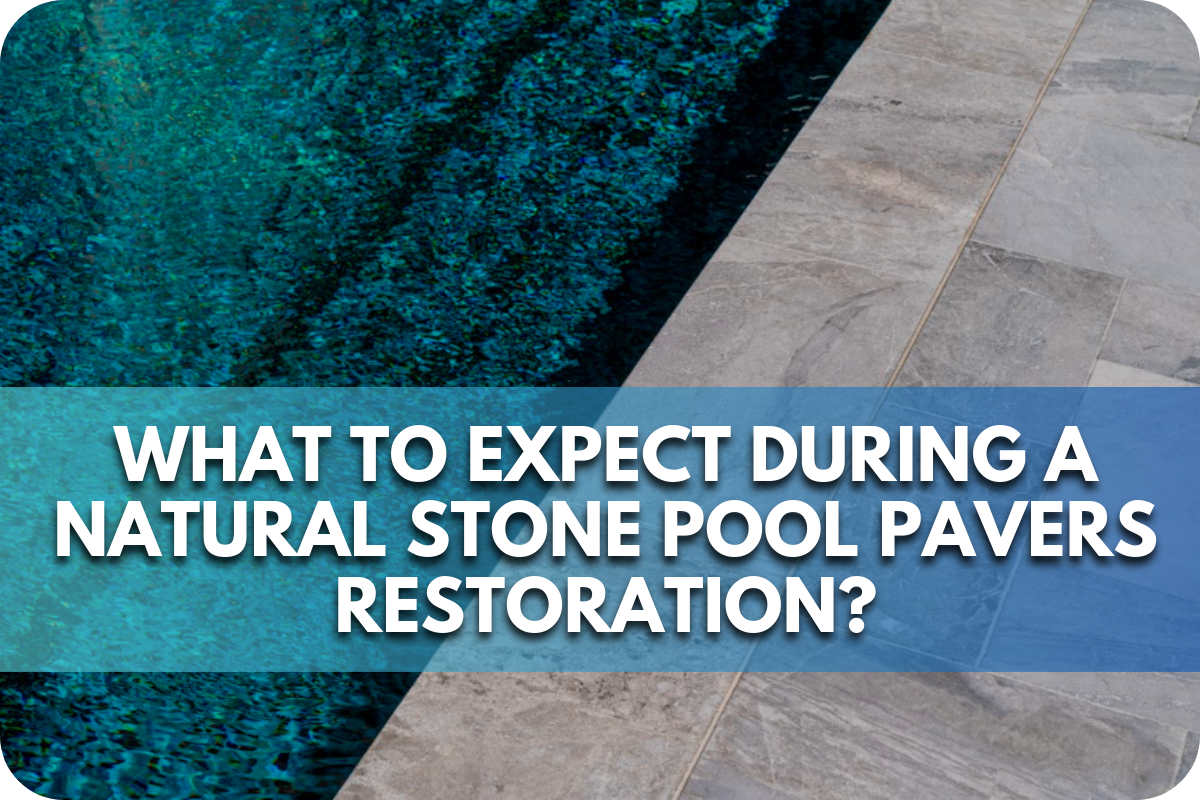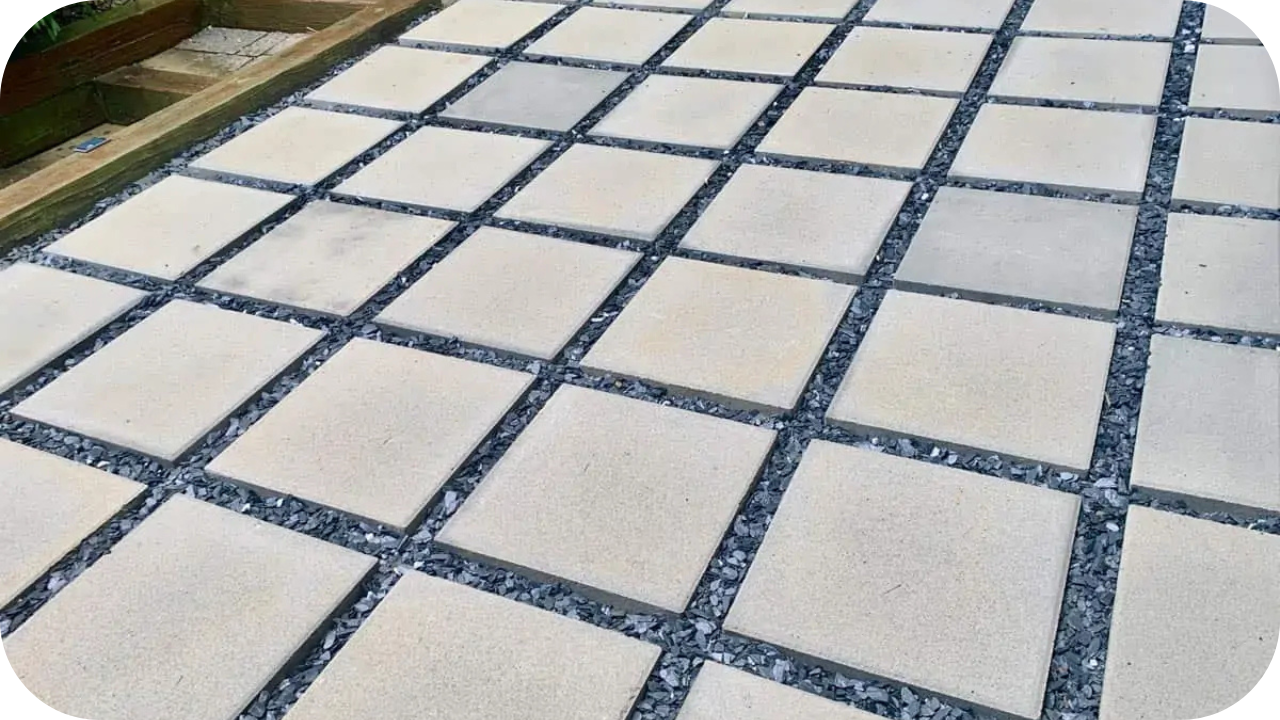
Over time, natural stone pool pavers can lose their lustre and become damaged, detracting from the beauty of your outdoor oasis.
Ignoring wear and tear leads to further deterioration and can compromise the safety and functionality of your pool area, turning what should be a relaxing environment into a concern.
Understanding what to expect during a natural stone pool paver restoration can help you revitalise your space effectively. This guide will walk you through the restoration process, ensuring your pool area returns to its pristine condition.
1. Assessment and Planning
The first crucial step in restoring natural stone pool pavers is a thorough assessment and detailed planning. This stage sets the foundation for a successful restoration, ensuring all issues are identified and appropriately addressed.
a. Assessment:
A professional restoration team will start by examining the current condition of your pool pavers. This includes looking for signs of damage such as cracks, chips, loosening, unevenness, and signs of wear like fading or staining.
They will also assess the level of degradation due to exposure to chemicals, water, and sunlight. The drainage around the pool area is checked to ensure that poor water management isn’t contributing to the stone’s deterioration.
b. Planning:
Based on the initial assessment, a detailed plan is developed, tailored to the specific needs of your pool’s stonework. This plan will outline the necessary restoration steps, including cleaning, repairing, releveling, and sealing the stones.
A timeline is set, and safety measures are planned to ensure the area’s safety during restoration. The plan will also include selecting the right materials and techniques specific to the type of natural stone to ensure that repairs blend seamlessly with the original stonework.
2. Cleaning and Preparation
The cleaning and preparation stage is critical for achieving optimal results while restoring natural stone pool pavers. This process involves several key steps to ensure the stone is adequately treated and ready for further restoration.
a. Cleaning:
The first step is thoroughly cleaning the pavers to remove dirt, grime, algae, and any chemical residues that could interfere with restoration. This is typically done using a pressure washer at a safe pressure setting that cleans effectively without damaging the stone.
A gentle, stone-safe cleaning solution may be applied and scrubbed with a soft brush for more stubborn stains or areas with significant buildup. This ensures that the surface is immaculate and free of contaminants.
b. Preparation:
Once the pavers are clean, the next step is to prepare the surface for repairs and sealing. This involves checking for loose or unstable pavers and re-securing them as needed. Any cracks or gaps must be filled with a matching stone filler to maintain a uniform appearance and structural integrity. The entire area is then assessed to ensure that it is level and that there are no trip hazards, especially around the pool’s edges.
3. Restoration Techniques
The restoration of natural stone pool pavers involves various specialised techniques to restore the stone’s integrity and appearance. Here’s an overview of standard restoration techniques used in this process:
- Repairing Damage: One of the primary steps in restoration is repairing any physical damage, such as cracks, chips, or loose stones. Epoxy resins that match the colour and texture of the original stone are often used to fill cracks and chips, providing a seamless repair that restores the surface to its original condition.
- Releveling Pavers: Over time, settling or erosion of the base material can cause pavers to become uneven. During restoration, these stones may need to be lifted and re-leveled. This involves adjusting the sand or gravel base layer beneath the pavers to ensure a flat surface, reduce trip hazards, and improve drainage around the pool area.
- Grinding and Honing: Grinding and honing may be necessary for pavers with surface scratches or etching. These processes involve using diamond abrasives to remove a thin layer from the top of the stone, revealing a fresh, unmarred surface underneath.
- Polishing: After grinding and honing, the pavers can be polished to restore their natural lustre. This is especially true for shiny stone types like marble or granite. The polishing process enhances the stone’s colour and provides a protective layer that makes the pavers more resistant to future wear.
- Sealing: Finally, a sealant is applied to protect the restored pavers from stains, water damage, and chemical exposure. The choice of sealant depends on the type of stone and the desired finish (e.g., matte, glossy). Sealing helps extend the life of the pavers and maintain their appearance over time.
4. Repair and Replacement
When restoring natural stone pool pavers, repairing and replacing damaged stones is crucial to addressing structural integrity and aesthetic consistency. Here’s how professionals handle this process:
a. Repair:
Minor damages, such as small cracks or chips in the stone, can often be effectively repaired using colour-matched epoxy or resin. This adhesive material fills the cracks or chips, bonding the pieces together while blending seamlessly with the original stone.
The repair compounds are carefully selected to ensure that they match the stone’s appearance and provide durability against future wear and weather conditions.
b. Replacement:
More extensive damage, such as profoundly cracked or broken pavers, may necessitate complete replacement. This involves removing the damaged paver from the surrounding material without disrupting adjacent stones.
Then, a new stone paver closely matching the original’s colour, texture, and size is installed.
Proper bedding and levelling of the new paver are critical to ensure it sits flush with the existing surface, maintains a uniform look, and prevents tripping hazards.
5. Sealing and Finishing
Sealing and finishing are vital final steps in restoring natural stone pool pavers, protecting the stone and enhancing its appearance. Here’s an overview of what this process involves:
a. Sealing:
Once repairs and cleaning are complete, sealing the pavers is essential to protect them from stains, weather elements, and chemical exposure from pool water.
The type of sealant used depends on the stone type and the desired aesthetic. Sealants can be impregnated, which penetrates the stone to protect it without altering its appearance, or topical, which forms a protective layer on the surface and can enhance the colour and finish of the stone.
Choosing a sealant that is suitable for wet areas and resistant to pool chemicals is essential.
b. Application:
The sealant should be applied evenly using a brush, roller, or sprayer, depending on the product instructions. Applying the sealant to a clean and dry surface is crucial to ensure it adheres properly and performs effectively.
Multiple coats may be necessary, with adequate drying time allowed between applications.
c. Finishing:
After sealing, additional finishing touches might include polishing the pavers to bring out their natural colour and enhance their texture.
Polishing not only improves the aesthetics of the stone but can also make the surface smoother and more resistant to accumulating dirt.
5. Maintenance and Care Instructions
Proper maintenance and care are crucial to extending life and preserving the appearance of natural stone pool pavers after restoration. Here are detailed instructions for maintaining your restored pavers:
- Routine Cleaning: Regularly sweep the pavers to remove debris such as leaves, dirt, and other materials that can accumulate on the surface. For more thorough cleaning, wash the pavers with a mild detergent mixed with water and a soft-bristle brush to avoid scratching the stone. Avoid using high-pressure washers, which can damage the stone’s surface.
- Immediate Stain Removal: Spills should be cleaned immediately to prevent staining, especially from acidic substances like wine or citrus juices. Blot the spill rather than wiping it to prevent the stain from spreading further.
- Regular Sealing: Depending on the type of stone and the sealant used, resealing should be done every one to two years. This is crucial for maintaining the stone’s resistance to water and chemicals, particularly in a pool environment. Always ensure the pavers are clean and dry before applying sealant.
- Avoid Harsh Chemicals: Do not use acidic or abrasive cleaners on the stone pavers, as these can etch the surface and degrade the sealant. Instead, use pH-neutral cleaning products specifically designed for natural stone.
- Inspect the pavers regularly for signs of lifting, shifting, or cracking. Addressing these issues promptly can prevent further damage and maintain the integrity and safety of the pool area.
6. Final Inspection and Approval
The final inspection and approval are critical stages in the restoration process of natural stone pool pavers. This step ensures that all restoration work meets the expected quality and safety standards before the project is officially completed.
- Detailed Review: The final inspection involves a comprehensive review of all restoration work by the contractor. This includes checking the alignment and level of the pavers and ensuring no uneven surfaces could pose tripping hazards. The inspector also examines the condition of the sealant and finish, verifying that they have been applied evenly and appropriately to protect the pavers from water, stains, and wear.
- Addressing Issues: If any issues are discovered during the inspection, such as incomplete sealing, loose pavers, or inadequate repairs, they must be addressed immediately. The contractor makes corrections to meet the project specifications and quality standards.
- Client Walk-Through: A walk-through with the client is conducted once the contractor has completed the final adjustments. This allows the client to view the work and raise any concerns. This step is essential for ensuring client satisfaction and gathering feedback.
- Approval and Documentation: After the client’s final approval, the contractor will provide documentation that outlines the details of the work performed, maintenance recommendations, and any warranties on the materials or craftsmanship. This document serves as a record of the project and a guide for future care.
Post-Restoration Care
Post-restoration care is essential to maintain the integrity and aesthetics of your newly restored natural stone pool pavers. Proper maintenance will ensure the longevity of the stone and prevent future deterioration. Here are critical practices for effective post-restoration care:
- Routine Cleaning: Regularly sweep or hose down your pavers to remove dirt, leaves, and debris. For more thorough cleaning, use a mild detergent and a soft brush to scrub the surface gently. Avoid using high-pressure washers or abrasive cleaners that could damage the stone.
- Prompt Stain Management: Address spills immediately to prevent stains from setting in. Natural stone can be porous, and spills, especially from oily or acidic substances, can penetrate the surface if not quickly removed. Use absorbent materials like paper towels or a clean cloth to blot spills.
- Periodic Sealing: Depending on the type of stone and the environmental conditions, resealing the pavers every one to two years can protect them from stains and weathering. Consult a professional to determine the best type of sealant for your specific stone and climate.
- Avoid Chemical Exposure: Minimise the stone’s exposure to harsh chemicals, such as chlorine and salt, which can erode the sealant and damage the stone. If these substances come into contact with the pavers, rinse them promptly with clean water.
- Regular Inspections: Inspect the pavers for signs of wear, such as cracking, chipping, or loosening. Early detection and repair of minor issues can prevent more significant problems and extend the life of the pavers.
Conclusion
Restoring your natural stone pool pavers revitalises your outdoor space, enhancing beauty and functionality. To ensure your restoration lasts, follow the provided care guidelines diligently.
If you need further assistance or wish to schedule routine maintenance, don’t hesitate to contact a professional restoration service. Keep your pool area pristine and welcoming for years to come.
More To Explore

Is Bluestone Ideal for Pool Surrounds?
When choosing the right material for your pool surrounds, Bluestone is a top contender due to its durability, aesthetic appeal, and practicality. Bluestone is known

Top Outdoor Paving Ideas for Aussie Backyards
Are you ready to transform your Aussie backyard with stunning paving ideas? Whether you’re looking to create a stylish outdoor entertaining area, a functional pathway,


